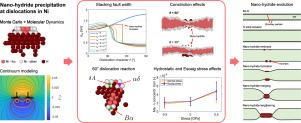镍中的位错纳米氢化物:成核、演化及其对位错行为的影响
IF 6
2区 工程技术
Q2 MATERIALS SCIENCE, MULTIDISCIPLINARY
引用次数: 0
摘要
在Ni-H体系中,纳米氢化物会在边缘位错的核心处析出,这是一种促进氢脆的机制。然而,对纳米氢化物的成核、生长及其对位错行为的影响却很少进行研究。这项工作结合了分子动力学大规范蒙特卡罗(MD-GCMC)模拟和连续体建模,揭示了与位错纳米氢化物相关的广泛现象。模拟结果表明,由于肖克利部分核心周围的静水应力,纳米氢化物可以稳定在所有特征角的位错核心处,包括螺杆段。这些区域发生了纳米氢化物的成核,其生长由完美位错的特征角θ决定。平衡层错宽度deq动态变化,增加了局部静水应力场,促进了纳米氢化物的形成,形成了一种类似收缩的特征,导致了三种不同的行为:当θ>;30°时deq减小,当θ=30°时deq保持不变,当θ<;30°时deq增大。远程流体静力和Escaig应力也会影响成核阶段,这意味着裂纹尖端前的应力集中可能促进纳米氢化物的析出。此外,我们还发现了一种新的氢诱导的60°位错反应,该反应在共轭平面上发出肖克利部分,这对孪核有潜在的影响。可测试的预测从这项研究,然后用来重新解释以前的结果从文献。这些发现为评估镍和其他面心立方金属位错中纳米氢化物的形成和演化提供了一个全面的框架,对氢脆具有重要意义。本文章由计算机程序翻译,如有差异,请以英文原文为准。

Dislocation nano-hydrides in nickel: Nucleation, evolution and effects on dislocation behaviors
Nano-hydrides have been predicted to precipitate at the core of edge dislocations in the Ni-H system, a mechanism that may promote hydrogen embrittlement. However, nano-hydride nucleation, growth, and effects on dislocation behavior have seldom been explored. This work combines molecular dynamics grand canonical Monte Carlo (MD-GCMC) simulations and continuum modeling to uncover a wide range of phenomena linked to dislocation nano-hydrides. Simulations reveal that nano-hydrides can be stabilized at dislocation cores with all character angles, including screw segments, due to the hydrostatic stresses around the cores of the Shockley partials. Nano-hydride nucleation takes place in these regions, and growth is dictated by the character angle of the perfect dislocation. The equilibrium stacking fault width varies dynamically to increase the local hydrostatic stress field and facilitate the formation of the nano-hydride, forming a constriction-like feature and leading to three distinct behaviors: decreases for , remains unchanged for , and increases for . Remote hydrostatic and Escaig stresses are also shown to influence the nucleation stage, implying stress concentrations such as those ahead of crack tips may facilitate nano-hydride precipitation. Moreover, we identify a new hydrogen-induced dislocation reaction that emits a Shockley partial on a conjugate plane, with potential implications for twin nucleation. Testable predictions from this study are then used to reinterpret previous results from the literature. These findings provide a comprehensive framework to assess nano-hydride formation and evolution at dislocations in nickel and other face-centered cubic metals, with important implications to hydrogen embrittlement.
求助全文
通过发布文献求助,成功后即可免费获取论文全文。
去求助
来源期刊
CiteScore
9.80
自引率
9.40%
发文量
276
审稿时长
52 days
期刊介绍:
The aim of Journal of The Mechanics and Physics of Solids is to publish research of the highest quality and of lasting significance on the mechanics of solids. The scope is broad, from fundamental concepts in mechanics to the analysis of novel phenomena and applications. Solids are interpreted broadly to include both hard and soft materials as well as natural and synthetic structures. The approach can be theoretical, experimental or computational.This research activity sits within engineering science and the allied areas of applied mathematics, materials science, bio-mechanics, applied physics, and geophysics.
The Journal was founded in 1952 by Rodney Hill, who was its Editor-in-Chief until 1968. The topics of interest to the Journal evolve with developments in the subject but its basic ethos remains the same: to publish research of the highest quality relating to the mechanics of solids. Thus, emphasis is placed on the development of fundamental concepts of mechanics and novel applications of these concepts based on theoretical, experimental or computational approaches, drawing upon the various branches of engineering science and the allied areas within applied mathematics, materials science, structural engineering, applied physics, and geophysics.
The main purpose of the Journal is to foster scientific understanding of the processes of deformation and mechanical failure of all solid materials, both technological and natural, and the connections between these processes and their underlying physical mechanisms. In this sense, the content of the Journal should reflect the current state of the discipline in analysis, experimental observation, and numerical simulation. In the interest of achieving this goal, authors are encouraged to consider the significance of their contributions for the field of mechanics and the implications of their results, in addition to describing the details of their work.

 求助内容:
求助内容: 应助结果提醒方式:
应助结果提醒方式:


